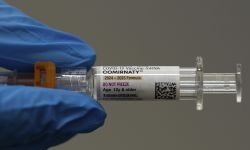Whitmer is holding off for now on Michigan COVID limits. Here’s why.

Dec. 7: Michigan Gov. Whitmer calls Biden’s vaccine mandate ‘a problem’ for businesses
Oct. 4: COVID outbreaks in Michigan schools already 8 times higher than last year
Sept. 30: Science says school masks work. Public opinion is another issue in Michigan
Sept. 22: Michigan GOP’s bid to block mask rules with budget looks dead on arrival
With Michigan’s coronavirus cases soaring and hospitals again filling up, Gov. Gretchen Whitmer has been reluctant to enact any new restrictions on businesses, schools or gatherings.
It’s a stark difference from the governor’s get-tough policies last fall.
So what’s different?
In mid-November, coronavirus cases were rising at almost the same rate they are now. That prompted the Whitmer administration to order a “pause to save lives,” shuttering dine-in restaurants and bars for three weeks while ordering high schools and colleges to discontinue face-to-face instruction.
Related:
- Republicans advance bills to bar Michigan school mask mandates
- Biden vaccine mandate: What’s it mean for Michigan schools, those who refuse?
- Michigan hospitals eye nurses in other countries to fill COVID shortage
- 2 million Michigan workers may be impacted by Biden’s vaccine mandate
- In Upper Peninsula, a COVID spike, a death threat and new school mask mandates
- A Michigan doctor goes to Facebook over dying, unvaccinated COVID patients
- COVID surge has largely missed Michigan. Has the state dodged a bullet?
- Michigan COVID nurses reach their limit: ‘I know I can’t do this forever’
- Despite protests, 98% of Henry Ford Hospital workers get COVID vaccinations
- Required COVID vaccines put Michigan hospital worker hesitancy to the test
The restriction on indoor dining was extended twice, amid howls from state Republicans, and restaurant and leisure industry officials. The ban was not lifted until Feb. 1.
Michigan restaurants have since been allowed to serve up to 50 percent of indoor capacity. Casinos, movie theaters and group exercise classes can operate. All of them were closed in November.
But after a four-week surge in cases, Michigan is now the No. 1 state for new infections. Yet Whitmer has said she’s not considering any economic restrictions — and in fact recently relaxed rules to allow the Detroit Tigers to welcome more fans to Comerica Park.
The governor points to several key factors that weren’t in place when she previously limited economic activity.
Among them: a confirmed 2.7 million Michigan residents have received at least one dose of a COVID vaccine.
"The difference between where we were a year ago and now is we know a mask is the best thing that you can do, social distancing," Whitmer said during a press event last week. "We have access to vaccines now."
Yet some are questioning her reluctance to reimpose more restrictions.
State Rep. David LaGrand, D-Grand Rapids, said he’d favor a two-week “pause” so more people could be vaccinated, with businesses allowed to stay open only if they service people who have been fully vaccinated.
But Whitmer is also receiving unlikely praise from a Republican lawmaker.
“There’s no guarantee she won’t change her mind, but it’s the right thing to do for her right now,” said Sen. Ken Horn, R-Frankenmuth. “It’s kind of an oddity that Michigan is one of the most locked down states and still has the highest rise in cases.”
The similarities to last fall
When looking at the current COVID-19 situation in Michigan, it’s eerily similar to the trends of October and November, with new cases, positive tests and hospitalizations rising at similar rates.
Let’s compare the beginning of the fall wave, which started on Sept. 30, to the start of the current wave, which began Feb. 18, based on three key metrics:
- Cases: On Sept. 30, Michigan reported a seven-day daily average of cases of 867. The seven-day average as of Feb. 18 was 847 cases.
And 42 days after each wave began, the daily average of cases had risen similarly. There were 5,040 average daily cases on Nov. 10, and 4,945 average cases as of Wednesday.
- Positive tests: Both surges started with about 3 percent of all COVID tests in the state coming back positive. A low positivity rate suggests that the virus is being largely controlled. But by the 42nd day of the fall surge, the positivity rate had surged to 11 percent. On the 42nd day of the current surge, it’s even worse, at nearly 13 percent.
- Hospitalizations: At the beginning of the fall surge, there were about 676 people in Michigan hospitals with a confirmed or suspected case of COVID-19, compared to 877 on Feb. 18.
Forty-two days into the fall surge, the number in hospitals was 2,959. On Tuesday, there were 2,446 confirmed or suspected COVID-19 patients.
The differences from last fall
Though the surge in cases was largely similar, there also are substantial differences between conditions last fall and this spring — differences that add context and may help explain why Whitmer is less likely to tighten restrictions now.
Vaccines
In the fall, vaccines were only a hope — none of the three currently approved vaccines had been approved for emergency use by the Food and Drug Administration and the only immunity from COVID was among the nearly 300,000 people in Michigan who had already contracted the disease.
At the time, the most vulnerable — those people age 70 and up — could only be protected by managing to avoid the virus. Though 11 percent of the state’s population, this age group comprised over 73 percent of the state’s 16,092 COVID-19 deaths.
A majority of older Michiganders now have vaccine protection. Nearly 70 percent of residents 65 and older have received at least the first dose of the vaccine, which helps explain why they make up fewer new coronavirus cases and hospitalizations.
“We are seeing differences in who is getting COVID-19,” Lynn Sutfiin, spokesperson for the Michigan Department of Health and Human Services, told Bridge Michigan Wednesday. “That’s where a lot of our vaccines have gone.”
Because seniors make up fewer cases and hospitalizations, there will likely be fewer deaths among the Michigan residents who now contract the virus, said Joshua Petrie, an epidemiologist at the University of Michigan.
Natural immunity
By the time Whitmer instituted her pause on Nov. 18, nearly 295,000 people had contracted and survived COVID-19 in the state. Now that number exceeds 730,000 with both confirmed and probable cases.
Most of those have some measure of immunity, though experts do not yet know how long it lasts. That means that between those people who have been vaccinated and those already infected, Michigan has over 3 million more people with some level of immunity — ten times more than when the previous pause was enacted.
Even so, Petrie said that number is not enough to stop the spread of the coronavirus in a state of nearly 10 million. “We know what stops this — masking and social distancing or immunity — and we’re just not there yet on immunity.”
Petrie said the decision last November to impose significant restrictions was “pretty easy.”
Now, the state’s most vulnerable residents have some protection, vaccines are quickly being administered, the improving weather will find people outdoors more and the state’s economy, which saw one of the highest unemployment rates because of the near shutdown of the leisure industry, is recovering.
There is another x-factor that may be guiding the governor’s thinking these days, Petrie said: many more residents may not be willing to follow another round of restrictions.
“You have to weigh all those factors,” Petrie said.
LaGrand, the Grand Rapids state representative, said another development argues in favor of a brief, targeted pause — the state received a record number of vaccines this week, over 554,000 doses, with another 620,000 expected next week as vaccine production ramps up.
But LaGrand acknowledged many in Michigan are tired of restrictions and that Whitmer faces a balancing act between the health of the economy and its citizens.
She also continues to face pressure from Republicans who control the legislature.
The Michigan Senate last week approved legislation that would set clear metrics for when and how the state could regulate restaurants during the pandemic, which they argued would provide business owners with more certainty so they could maintain staffs and supplies.
Ironically, under the plan, the recent rise in virus metrics would have prompted tightening restrictions if it were in effect. The state should have already reduced indoor restaurant capacity from 50 percent to 25 percent because the seven-day testing positivity average is currently above 10 percent. If the positivity average climbs above 15 percent, restaurants would have to close dining rooms all together, under the GOP plan.
For now, though, Horn, the Frankenmuth Republican, indicated he is content with the governor’s patience.
If the recent rise in cases involves younger people “who can withstand it and are healthier, let’s just keep on a straight path,” he said. “So I think the governor is doing the right thing.”
See what new members are saying about why they donated to Bridge Michigan:
- “In order for this information to be accurate and unbiased it must be underwritten by its readers, not by special interests.” - Larry S.
- “Not many other media sources report on the topics Bridge does.” - Susan B.
- “Your journalism is outstanding and rare these days.” - Mark S.
If you want to ensure the future of nonpartisan, nonprofit Michigan journalism, please become a member today. You, too, will be asked why you donated and maybe we'll feature your quote next time!








